Home Site Map - Steps - Foundations -
Form Footing
Form-a-drain
What is it used for?
If you look at the foundation design here you will see that a product called Form-a-drain is used on both sides of the footing. Details on Form-a-drain can be found here . The Form-a-drain is a 10 inch by 1-1/2 inch rectangular hollow cross-section and comes in 12 foot lengths that you connect together to go all round on both sides of the footings. It has slots in it to let the water in and it forms a rectangular pipe to drain the water away. That pipe round the footings also provides a way of venting off any radon gas that might come up from the earth. Another job the Form-a-drain performs is to form the sides of the footings to keep the concrete where you want it while it's setting. Lastly, it is used as a nice stable reference point to set the height of the concrete slab. The screeding of the slab concrete is done by using the top edge of the Form-a-drain. Form-a-drain is well suited to being a reference compared with say wood because it is more dimensionally stable and uniform.
Foundation design
(Click on image to see high resolution version)

Looking at the foundation drawing you will see that there is Form-a-drain at the bottom of the footing trench on the inner and outside edges, just inside where the stakes are banged in. The stakes make sure the bottom Form-a-drain stays in place laterally and is also used to attach the upper Form-a-drain .
It is best to use corrosion-proof rebar rather than steel rebar because the stakes will stay in place and corrosion-proof rebar does not rust. Also corrosion-proof rebar does not bend (or at least does not stay bent).
Cut Form-a-drain
Required lengths
The required lengths can be determined by looking at the foundation drawings. The green line in the drawing below is the outer Form-a-drain and the blue line is the inner Form-a-drain. Note that there is also Form-a-drain used for the footings under the internal ICF walls.
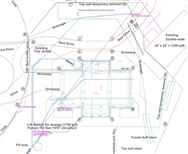
When cutting the lengths of Form-a-drain you need to subtract an amount for the Form-a-drain corner pieces. For the inside bend the amount is 1" per piece, and for outside of the bend the amount is 2.5" per piece.
In the case of my evaluation building, the outer edge of the outer rectangle needs to be 17'4" x 13'4", so that means two of the outer adjustments of 2.5", which means it needs two pieces of 16'11" and two pieces of 12'11". Given that the Form-a-drain comes in 12' lengths, it is necessary to join pieces using connector pieces.

To get the inner edge of the inner Form-a-drain, the rectangle is the wall center of 14'x10' minus two lots of 20" which makes 10'8"x6'8". With the allowance for the Form-a-drain corner pieces (inside bend, so two lots of 1"), that means two lengths of 10'6" and two lengths of 6'6".
Fit drainage fabric round the Form-a-drain
You need to avoid the Form-a-drain getting clogged up with soil as it is fairly hard to clean out compared with 4" perforated drain pipe. To avoid soil getting in you need to cover the slots with filter cloth. You need this on the Form-a-drain that goes at the bottom of the footing ditch and on the inner top Form-a-drain. The outer top Form-a-drain is used as a reference rather than for drainage so you don't need or want filter cloth on it.
The best filter cloth is the type that comes in rolls of sock for 4" drainage pipes. It will stretch over the 10" Form-a-drain ok.
Here's a picture of a section of 10" Form-a-drain covered in the sock...

Here's what the sock covering looks like at the corners...

Rest in place over drain pipes
Rest the Form-a-drain in place over where the drainage pipes with the upward facing T pieces are. Make sure they are at the right height relative to the batter board strings (65.5" below grade, which in my case is also 65.5" below the batterboard strings).
Implement drainage pipe connection from the Form-a-drain
Custom design
There will be a hole cut in the bottom of the Form-a-drain as it passes over the drainage pipe that was installed previously. To catch the water, the drainage pipe has upward facing T pieces. To guide the water from the Form-a-drain to the T pieces, short pieces of solid wall 4" drainage pipe cut with a 1.5" slot are used. A cap piece also cut with a 1.5" slot completes the assembly.

Here is a picture of the T pieces that were previously implemented in the drainage pipe that passes under the Form-a-drain.

Cut holes in bottom of Form-a-drain
Directly above the drainage pipe T pieces you need to cut holes in the bottom of the Form-a-drain. This can be done using a hacksaw and cutting a 1.5" shallow U in the side on the Form-a-drain at the bottom edge.
Fabricate and attach the guide pipe assembly
Measure and cut the necessary length of 4" solid wall pipe. Cut the 4" piping with a slot in the top to guide the water to the T piece. Also cut the top cap as shown in the picture below (use a hacksaw).

Assemble the parts. You don't really need to glue it as it will stay in place without problems, but if you do decide it needs gluing then use PL Premium Construction Adhesive .


Install Form-a-drain
Assemble Form-a-drain to make perimeters
The lengths of Form-a-drain will be joined using the coupling pieces that are part of the Form-a-drain product range. There are straight joins and right angle joins.
Fit the corner pieces to join together the Form-a-drain to make the lower inner and lower outer Form-a-drain perimeters for the bottom of the footing trench. Attach the corner pieces by drilling small pilot holes through the connector pieces and into the Form-a-drain, make the holes clearance size in the joining pieces, and then use self tapper screws. Using construction adhesive doesn't help much because it will not stick to the plastic used for the connector pieces.
The slits need to face outward from the trench on both the inner and the outer Form-a-drain. The plain side is against where the concrete will be.

Internal ICF wall T pieces
Where there are internal ICF walls then you will need to make T piece connectors so that any water that collects from the internal wall will flow to the Form-a-drain round the inside of the perimeter wall footing. The T pieces need some ingenuity but don't need to be perfect or completely water tight. You can use a couple of straight length connector pieces to make a T piece, or you can join the straight pieces directly. Use creative cutting, flaring, gluing, and screwing.
Place the Form-a-drain in the right location
The Form-a-drain needs to be laid exactly horizontal (on its edge). This will be what it is if you have done an accurate job with your footing trench excavation, but realistically you need to accurately check it with a tape measure from the batter board strings and a self leveling laser, and make any adjustments needed. The Form-a-drain needs to be exactly level so that water does not accumulate in it. If necessary, add a few selected stones to get it padded out to the right height and levelness.
The distance between the outer faces of the Form-a-drain needs to be 40 inches. Position the lower inner and lower outer Form-a-drain in the exactly right positions. This is done using a plumb bob hung down temporarily from the batter board strings. A hook made out of a bit of garden wire allows the plumb bob to easily be moved to different places.
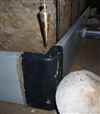

When you are done, you should have a joined rectangle all the way round the outside of the footing and another one all the way round the inside of the footing. If your house is more complicated than just a rectangle then you will also implement a continuous border inside and out, but you will need more connector types and the result will something more complicated than a rectangle.
Install rebar stakes
Stake lengths
As you can see in the foundation drawings, vertical rebar stakes (shown in purple) are driven into the ground at the bottom of the footing trench and the Form-a-drain is attached to the rebar stakes.
The outside stakes need to be about 58.5 inches long and the ones on the inside of the footing trench need to be about 45.5 inches long. That corresponds to them going into the ground 18 inches. If because of a rock you are not able to hammer it in 18" then you will cut the rebar off at the top to make it the right distance above the bottom of the ditch. If you have lots of rocks you may have to have several attempts at finding a suitable location along the Form-a-drain where it will go in. You may also find that sometimes a stake goes in badly crocked and has to be cut off at ground level and re-done.
When everything is done right, and the stakes have been either banged in or cut off to the right height, the top of the outer rebar stakes should be one inch below the height of the top of what will be the floor slab (ie 1 inch below the top of the outer top Form-a-drain) and the top of the inner stakes should be one inch below the height of the bottom of the polystyrene sheet that is under the slab (ie 1 inch below the top of the inner top Form-a-drain).
For internal ICF walls you will use the shorter inner stakes on both sides of the footing. In my case, on the main house, the wall between the portico bases and the primary house rectangle is an inner wall (as are the actual inner ICF walls).
Bang in the stakes
You will need to put rebar stakes about every 2 to 3 feet to provide enough support for the Form-a-drain. The exact spacing and positioning along the Form-a-drain length does not matter. Use the Form-a-drain to guide where the stakes need to be, but make sure the Form-a-drain is in the right location using a plumb bob off the batter board strings. Make sure the Form-a-drain does not move when banging in the stakes and if it does then use the plumb bob to get it back to the right location. Also make sure the Form-a-drain is not warped and if it is then compensate for this when putting in the stakes (fixing the Form-a-drain to the stakes should un-warp the Form-a-drain).
When deciding where to put the stakes for the outer Form-a-drain, try to make sure they are in suitable places for later attaching polystyrene sheet to. That means they should be about a foot either side of where you plan to implement the pipe spacers (see later).
At the corners of the outside Form-a-drain, put stakes half way between the corner and the spacer pipe nearest the corner. This will be used to attach the polystyrene sheet at the corners.
Bang the stakes in vertically with a Club Hammer. The string to the plumb bob will help guide you to be vertical in both axis. Realistically the stakes may wander a bit when banged in, but as long as they are within half an inch of the edge of the Form-a-drain then you will be fine. They also may not be exactly vertical due to rocks, but a bit of variation is ok.
Cut off stakes to correct length
After the stakes are firmly in the ground, for the inner stakes measure 27.5" up from the bottom of the trench and cut the rebar off to this height. For the outer stakes, the cut-off height is 40.5" above the bottom of the trench. These cutoff heights assume the ditch bottom is at 65.5" below grade. If it's accidentally an inch deeper then add an inch to the cutoff heights.
Position and level lower Form-a-drain
Get Form-a-drain the right height
You need to get the Form-a-drain to be accurately at the right height relative to the batter board strings and to make it accurately level. You also need to make sure using plumb bobs that the corners are exactly under where the batter board strings cross as this will get the building in the right place and more importantly ensure the corners are square. If necessary to get the right height (65.5" below grade, which in my case is also 65.5" below the batter board strings) you may need to chip away a few soil mounds or build up the ground a bit with a few selected stones.
Cleanout and radon venting
Overview
To allow radon gas to vent out through the building roof and to provide a way to route flushing water into the Form-a-drain to clean it out, a 4" diameter stack pipe will attach to the top inner Form-a-drain. The 4" pipe ideally needs to come up through the slab (because radon gas is lighter than air). The footings and slab form an umbrella that will catch any radon gas and this needs to be provided with a path upwards from the underslab area so it can escape.
In my area there is not actually a radon gas problem, and there is no building code requirement, so I can do without a radon vent. I have decided to route the radon vent pipe under the footing rather than have it come through the slab.
For my main house foundation there are actually 3 potential radon collection because the underslab area within the footings (including the internal ICF footings) forms three umbrella-like compartments. I have decided to connect the areas together with pipes under the internal wall footings and then I will provide one inlet vent on the west side and one exit vent on the east side. If I ever needed to flush out gas from under the footing (very unlikely in my area) then I would blow in air on the west side inlet vent. I could also use water to flush everything out.
Put the vent pipe connections at the opposite ends of the Form-a-drain from the water drain pipes that go to the lower Form-a-drain. This is to provide a good route for cleanout water.
The 6 mil polyethylene sheet that is directly above, level with the top edge of the top inner Form-a-drain, will help trap any radon gas and route it into the Form-a-drain and out via the vent pipe. The polyethylene sheet needs to be well sealed to the pipe, both to keep the gas contained and to avoid water getting into the basement.
Implement
Drill a 4" hole in the upper inner Form-a-drain near the top. Fit the 4" pipe with a 90 degree bend. Use a 90 degree bend that has a male on one end and a female (hub) on the other end. Use the male end into the 4" hole cut in the Form-a-drain. Fit a collar piece made by cutting a thin ring off the end of a 4" straight connector piece. Use the special green plumbing glue that is designed to glue PVC to ABS.


Attach inner top Form-a-drain
Assemble it
Join together pieces of the right length to make a perimeter that is the same dimensions as the inner lower Form-a-drain. It's best to assemble it by resting it on the lower perimeter of Form-a-drain.
This is the third perimeter of Form-a-drain, and like the previous two is also used for drainage, so it needs the filter cloth sock and its slots face outwards from the footing trench. It attaches at the top of the short inner rebar stakes. The gap between the bottom and top Form-a-drain should be exactly 8.5 inches (ie exactly 18.5" on center given that the Form-a-drain is 10" tall). It will attach to the stakes with tie wraps, hot-melt glue, and PL Premium construction adhesive glue.
Implement pipes from inner top Form-a-drain to bottom inner Form-a-drain
These 8.5" long 1.25" bore pipes strategically spaced around the perimeter are to allow water collected in the top Form-a-drain to drain to the bottom Form-a-drain so it will then flow to the 4" drainage pipes and away. They need to be placed such that flushing cleanout water from the top Form-a-drain enters the bottom Form-a-drain a decent distance from where the lower Form-a-drain connects to the 4" drainage pipe. You want this flushing water to cleanout any silt in the lower Form-a-drain. Think about the path for the flushing water when deciding where to place the pipes.
The pipes are made using 8.5" lengths of 1.25" PVC water pipe into which internal collar pieces made from 1" PVC water pipe are glued. The 1" pipe as it protrudes 1/8" out of the 1.25" pipe will fit into a 1.25" hole drilled in the Form-a-drain.



They act as convenient spacers to get the right distance between the upper and lower Form-a-drain. As such it is worth implementing a good number of dummy pipes that act purely as spacers. These are just 8.5" lengths of 1.25" pipe but without the holes in the Form-a-drain or the inner collar pieces of 1" pipe. Just glue them in place wherever needed. You will need to cut away the filter cloth and then use PVC water pipe glue.

Measure to make sure the spacing between the upper and lower Form-a-drain is exactly right. Also use a self leveling laser to make sure it is exactly level.
After the upper inner Form-a-drain has been installed on top of the pipes (some dummy and some water drainage), this is what it looks like...
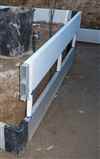
Install cleanout pipe to outer lower Form-a-drain
It's good to have a way to inject high pressure water into the outer lower Form-a-drain in order to be able to clean it out if it gets clogged. A 5 foot length of 1.25" PVC water pipe glued into a hole in the top edge of the outer lower Form-a-drain will provide the necessary mechanism. It will be slightly sloping back rather than completely vertical (so it misses the outer upper Form-a-drain).
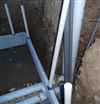
Attach outer top Form-a-drain
The reference
This is the forth and last perimeter of Form-a-drain. Its outer top edge is used as the reference for the foundation. The top edge is the height of the top of the concrete floor slab. Its outer face corresponds exactly to the green line on the foundation drawing that was used to layout the position of the building. The center of the walls will be exactly 20 inches from the outer face of this Form-a-drain.

Select the straightest pieces of Form-a-drain for use as this critical reference. This reference piece of Form-a-drain is not used to collect water so does not need or want to have filter cloth. It is installed with the slots facing inwards into the footing trench.
Pipe spacers
Even though there are no water drainage pipes needed from the outer top Form-a-drain, it is still necessary to implement dummy pipes as spacers. In the case of the outer Form-a-drain the spacer pipes need to be 21.5" long. You need to cut 1.25" PVC water pipe to lengths of 21.5". You need enough to be able to have spacers about every 4 or 5 feet and on either side of corners.


Assemble it
Join together pieces of the right length to make a perimeter that is the same dimensions as the outer lower Form-a-drain. It's best to assemble it by resting it on the lower outer perimeter of Form-a-drain.
Fit it
It is attached at the end of the longer outer rebar stakes (rebar stakes are about 1" shorter than the top of the Form-a-drain). The gap space between it and the bottom outer Form-a-drain is 21.5 inches (which is 31.5" on center given that the Form-a-drain is 10 inches tall).
Using galvanized wire through holes is a good way to hold the Form-a-drain to the spacer pipes.

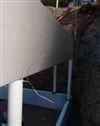
It goes without saying that you need to set this very accurately. You also need to use a self leveling laser to make absolutely sure that it is exactly level.
Secure Form-a-drain locations
Make some lower Form-a-drain width jigs
In order to ensure the formed footing is the correct width at the bottom, and to take out any bowing in the Form-a-drain, it is useful to make up some pieces of 2x4s to act as jigs that can slot over and between the inner and outer lower pieces of Form-a-drain. The 2x4s are 43" long and have 1.5" slots on each end to slot over the Form-a-drain.

They ensure the outer edges of the Form-a-drain are exactly 40" apart.

Note that in most cases the forces associated with the crushed rock backfilling will push the Form-a-drain closer together so in most cases just cutting 2x4s that are 37" long is a better choice than using jigs that slot over. The Form-a-drain is also wired to the rebar stakes to stop it from moving.
Make upper jigs
In order to make sure the inner and outer upper Form-a-drain is exactly 40" between the outer edges, it's good to make a few jigs from 2x4 lumber. Because the outer Form-a-drain is higher that the inner Form-a-drain, it needs a jig with one U on the top and the other U underneath. The actual distance between the top of the inner Form-a-drain and the bottom of the outer Form-a-drain is 3" so given that a 2x4 is 1.5" you need to pad one of the U's with a 1.5" piece of wood.


It is arguable whether many or any jigs are actually needed given the bracing round the upper outer Form-a-drain and the wires across the slab area.
Wire on the jigs
To attach the jig given that one of the U's is up-side-down you need to use some galvanized wire over the upper outer Form-a-drain.
Wire between inner upper Form-a-drains
Put galvanized wire across the earth of the slab area between the inner upper Form-a-drain . This is to ensure that the Form-a-drain will not bulge out when the crushed rock is added to the slab area. These wires will stay in place, but it won't matter if they rust away after the concrete is poured. Drill holes either side of the Form-a-drain center divider as that will be strongest. Measure that the distances between the Form-a-drain are correct and tension the wires to ensure the correct dimensions.
Wire lower Form-a-drain to stakes
Attach the lower Form-a-drain to the stakes (both the inner and outer lower Form-a-drain) using galvanized wire through holes half way up the Form-a-drain either side of the center divider. This is necessary in order to take the force of the crushed rock backfilling. Make sure the fixing is really secure and strong as there will be lots of force from the crushed rock.
Make and install outer upper lumber bracing
The outer upper Form-a-drain is susceptible to bending and warping and generally flapping around. It needs to be stiffened up so that it stays straight. This is done by attaching 2x6 lumber round the outside. The 2x6s are attached using 2x4 spacer pieces to avoid the rebar stakes (and of course a bit of spacing helps increase the overall strength of the assembly). You will need to measure to determine the actual distances between the stakes and their actual locations, make a sketch drawing, and then fabricate the lumber assembly to fit the Form-a-drain and stakes. You will need to make them in sections as the 2x6 lumber is typically only about 8 or 10 foot long. Choose only nice straight lumber. Here are some typical pieces...



Attach the lumber strengtheners using 2.5" wood screws into the Form-a-drain about every 4" in the spacer pieces. The lumber assembly should be installed 1.6" below the top of the Form-a-drain so it is clear of the top reference edge (even if an extra buttressing piece of 2x4 is added on top). As an added precaution, also use galvanized wire to securely attach at the ends and at the center. This is just in case the screws into the Form-a-drain plastic fail.
Connect the lengths of 2x6 lumber using 4' lengths across the joins.

Ensure the Form-a-drain is exactly straight as you attach the joining pieces. This can be done by looking along the length to ensure straightness.

Also use overlapping pieces of 2x6 at the corners.
Some creativity may be needed to avoid cleanout pipes.


Implement mid-way bracing for upper Form-a-drain
When there is a long length of Form-a-drain it is not sufficient to rely on the lumber bracing to hold it straight and in the right location. Additional creative bracing to the earth bank is needed to keep things straight.
Check and double check
When you have installed the Form-a-drain all the way round the building, do some additional checking for levelness by shining a self leveling laser level across from one side to the other in multiple places.
Hopefully the Form-a-drain will all be level because the lower Form-a-drain was previously leveled and the spacers were all accurately cut to length. If any slight adjustment to the levelness of the upper Form-a-drain is needed then this should be done by slight padding under the lower Form-a-drain.
The distance to the top of the inner upper Form-a-drain from grade should be 37" which in my case is also 37" below the batter board strings. The distance from the top of the outer upper Form-a-drain to grade should be 24" which in my case is also 24" below the batter board strings.
Here's what things should look like after all the Form-a-drain is in place...

Install outside 4" perforated drainage pipe
Outside the lower outer Form-a-drain
Round the outside of the footing trench there needs to be a 4" perforated drainage pipe, or as it's sometimes called, a "weeping tile". It connects into the two wye connectors previously installed in the drainage pipe that runs down the trench from the building. The outside drainage pipe needs to be installed this early in the build process so that crushed rock can be placed behind the lower outer Form-a-drain to balance the forces associated with filling the under-slab area with crushed rock.
Short right angle pieces are used at the building corners. Using short turns keeps the pipe close to the Form-a-drain .


Line the outside with geo-fabric
The geo-fabric goes from the lower outer Form-a-drain, under the perforated drain pipe, and then up the outside of the excavation. Leave enough spare length to be later able to fold it over the outer excavation back to the wall just below grade. The cut strips of geo-fabric need to be 10 feet long.

Bed of drain rock
Prior to installing the 4" perforated pipe, lay down a thin layer of 1.25 inch crushed rock without fines for it to lie on. Near the outlets the bed should be about an inch, but it should gradually get thicker as it goes back in order to give the pipe a slight slope. Something like 1/8" per foot is sufficient. Certainly you should check that there are no places where the gradient is the wrong way.
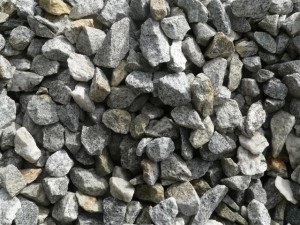 1.25 inch crushed rock without fines
1.25 inch crushed rock without fines
Clean-outs on the far side
The drainage pipes go all the way round the outside of the footing trench on the outside of the lower outer Form-a-drain. On the far side the left and right halves don't actually join, but rather they go up vertically to provide clean-outs.

Polystyrene between Form-a-drain
Function
Between the upper and lower Form-a-drain you need some 1.5" thick polystyrene sheet. It needs to be cut into strips that are 8.5" wide for the inner Form-a-drain and 21.5" wide for the outer Form-a-drain. It is worth getting these widths right so that the polystyrene is a good interference fit between the Form-a-drain. You need to edge it in there by beating on it with the palm of your hand. You measure the inside distance between the spacer pipes and cut the polystyrene strips to that length.
Expanded Polystyrene Sheet (EPS)
The best choice for between the Form-a-drain is 1.5" thick Expanded Polystyrene Sheet. Most of the other EPS used is 2" thick.
Cut EPS sheet with carving knife
Using a sharp serrated carving knife works well for cutting polystyrene sheet.

Inner Form-a-drain
Fit the 8.5" strips of polystyrene sheet between the inner Form-a-drain.

Outer Form-a-drain
Fit the 21.5" strips of polystyrene sheet between the outer Form-a-drain.

Fix inner Form-a-drain filler strips
Why needed
Between the inner Form-a-drain it is necessary to prevent the backfill drain rock and the filler polystyrene from falling out ahead of having the footing lining done. To prevent this it is necessary to fix some thin plastic board between the upper and lower inner Form-a-drain. It should be a 1 foot wide strip cut from 8'x4' sheeting. Suitable sheeting is about 0.060" thick PVC.

Attaching
Use self tapping screws on the top and bottom edges to attach the PVC sheet to the Form-a-drain.
Fixing polystyrene on outer Form-a-drain
Attaching to rebar stakes
The outer stakes need to be attached to the upper outer Form-a-drain. Drill two wiring holes either side of the central divider of the Form-a-drain. (The center divider is half way up and divides the two drainage channels inside the Form-a-drain.)

Outer EPS sheeting
The EPS between the outer Form-a-drain is held in place (from the inward pressure of the crushed rock backfill) by having a wider sheet of EPS on the outside of the Form-a-drain. This extra EPS provides important insulation for the footing.
Implementation
As you will see on the foundation drawing the additional 2" EPS sheeting is placed on the outside of the outer Form-a-drain . It overlaps the bottom of the top outer Form-a-drain by 1.5" (so that it is under the lumber bracing) and overlaps the bottom Form-a-drain by 1" (to provide a mechanical stop, yet not cover the drainage holes). The overall width of the outer EPS is 24" (which is conveniently half a 4' wide sheet). You will need to cut it and/or groove it to avoid the rebar stakes and any lumber jigs that are in the way. It does not have to be perfect and a few holes and gaps don't matter.
The outer sheet is glued to the sheet between the Form-a-drain using a thin layer of foam adhesive .
Heads-up for the future
Note that after the concrete pour for both the foundations and the basement ICF walls, the last 7" up to the top of the Form-a-drain can also have 2" EPS sheet added, but this cannot be now because the lumber bracing needs to be removed before this can happen.








